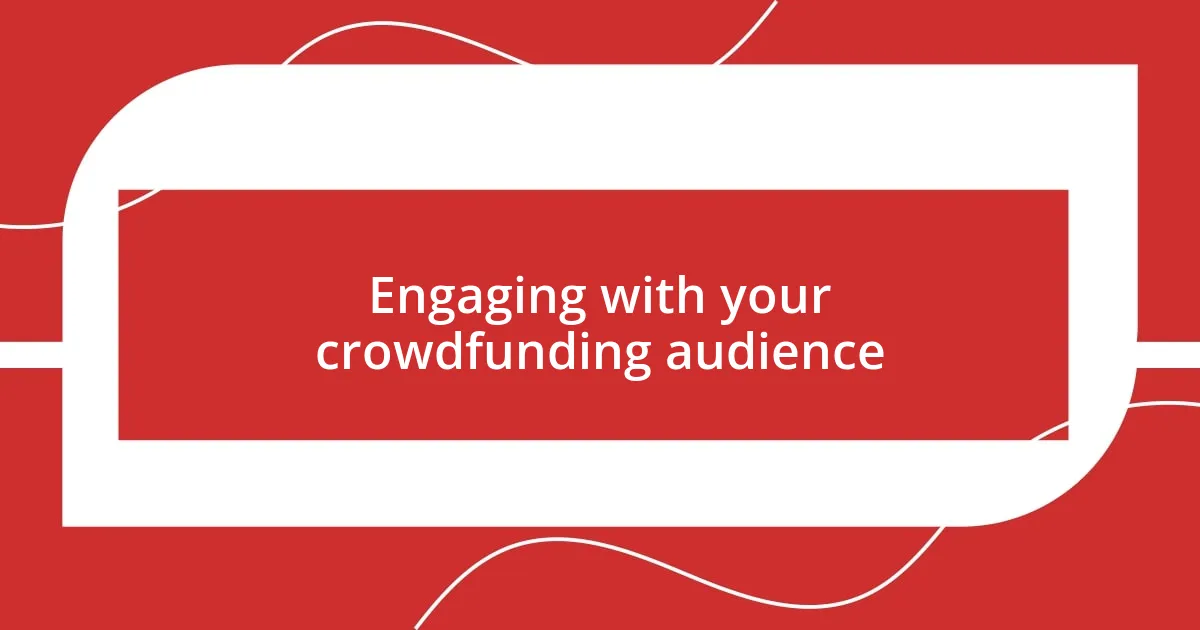Key takeaways:
- Crowdfunding is about gathering community support, requiring clarity in project goals and effective engagement.
- Choosing the right crowdfunding platform is crucial; consider platform alignment with project type, user-friendliness, and fee structures.
- Crafting a compelling narrative and utilizing visuals can enhance emotional connections with potential backers.
- Consistent and targeted marketing strategies, along with audience engagement, foster a loyal community around your project.

Understanding crowdfunding basics
Crowdfunding is about harnessing the power of community to fund projects that matter. I remember launching my first campaign and feeling a mix of excitement and dread at the thought of putting my idea out there. It’s an emotional rollercoaster—will people connect with my vision, or will it all fall flat?
At its core, crowdfunding involves individuals contributing small amounts of money towards a larger goal, often facilitated by online platforms. I’ve found that this model encourages creativity and connection; it’s not just about the money but also about rallying support from those who believe in your mission. Have you ever thought about how such funding could change your life? It’s amazing how many people you can reach when you share your passion.
Understanding the various types of crowdfunding—like rewards-based, equity, or donation-based—is crucial. Each method has its distinct charm and potential challenges. I once chose a rewards-based model and learned that thoughtful incentives can make a significant difference in backer engagement. What would you offer to inspire others to contribute to your dream?

Choosing the right crowdfunding platform
When it comes to choosing the right crowdfunding platform, I’ve learned that it’s essential to align your project goals with what each platform offers. For instance, Kickstarter tends to focus on creative projects, while Indiegogo has more flexibility for various causes. I remember having to make this choice myself; I initially rushed into selecting a platform, only to realize later that it didn’t cater well to my specific audience. It taught me the importance of understanding my target backers and what motivates them.
Ease of use is another critical factor. Some platforms provide intuitive interfaces that make it simple to set up a campaign, while others can feel a bit clunky. After my first experience, I decided to prioritize user-friendliness when launching subsequent campaigns. I’ve found that a seamless experience makes it easier for potential backers to engage. Have you ever hesitated to support something because the process felt daunting? It’s something worth considering as you make your choice.
Lastly, look closely at the fee structures. Some platforms charge a percentage of the funds raised, while others might have flat fees. I encountered this dilemma during my early campaigns, and it made a real difference in how much of the funds I ultimately took home. Understanding the financial implications can help you budget better and make informed decisions.
| Platform | Type | Fees | User Friendliness |
|---|---|---|---|
| Kickstarter | Rewards-based | 5% + payment processing | Moderate |
| Indiegogo | Flexible (Rewards/Equity) | 5% + payment processing | Easy |
| GoFundMe | Donation-based | 0% (payment processing only) | Very Easy |
| SeedInvest | Equity | 7.5% + payment processing | Moderate |

Setting clear project goals
Setting clear project goals is crucial for the success of any crowdfunding campaign. I remember a pivotal moment when I defined my project with specific, measurable objectives. It transformed my vision from vague dreams into actionable steps, which not only clarified my approach but also inspired confidence in potential backers. When people can see what you’re aiming for, they’re more likely to rally around your cause.
To ensure your project goals resonate, consider the following:
- Be Specific: Instead of saying “I want to create a great product,” state “I need $5,000 to produce 500 units of my eco-friendly water bottle.”
- Keep It Measurable: Define what success looks like. For example, “I will launch within three months and gain 1,000 backers.”
- Align with your audience: Think about what your potential backers care about. Knowing their interests can help shape your project goals.
- Stay Realistic: It’s essential to set attainable goals. I once overestimated my reach, which led to disappointment. Aim for ambitious yet achievable targets.
- Regularly Review and Adjust: Monitor progress and be flexible. If certain goals aren’t resonating, don’t hesitate to tweak them to better connect with your audience.
Each of these strategies has shaped my approach and ultimately prepared me for the funding process. Do you feel that clarity around your goals could make a difference in your project?

Creating an engaging campaign story
Crafting an engaging campaign story is about weaving your personal journey into your pitch. I remember when I first shared my project’s backstory; it was a game-changer. Instead of just presenting facts, I painted a vivid picture of the challenges I faced and the passion that fueled my idea. I could see the sparkle in my audience’s eyes as they connected to my journey. Hasn’t a powerful narrative ever made you feel a part of something bigger?
Adding emotional elements can make a significant difference. During one of my campaigns, I shared a heartfelt moment that inspired my project—a story about how I was moved by a particular experience. This genuine vulnerability resonated with backers, who felt they were not just supporting a project but joining a mission. Creating this emotional connection is crucial; it invites them into your world. Does your story evoke the kind of feelings that can spark support?
Visuals also play a vital role in storytelling. I learned that images and videos can evoke emotions and thoughts that words sometimes can’t fully capture. For my campaign, I used a short video showing my prototype in action, which allowed potential backers to see and feel the impact firsthand. This visual engagement compelled more people to share my story widely. Think about it: how would your audience react to seeing the passion behind your project through engaging visuals?

Building a strong marketing strategy
Building a strong marketing strategy involves knowing your audience inside and out. In one of my campaigns, I took the time to create detailed buyer personas based on demographics, interests, and online behavior. This deep understanding shaped everything from my messaging to the platforms I chose to promote my project. Have you thought about who exactly you’re speaking to, and how that could impact your outreach?
I also found that utilizing social media effectively can amplify your reach exponentially. I remember when I launched a teaser campaign on Instagram; it built excitement and anticipation before the official launch. The response was fantastic, and people eagerly awaited the project release. Social media isn’t just about posting updates; it’s about engaging with your community. What platforms resonate most with your target audience, and how are you leveraging them to create buzz?
Don’t overlook the importance of consistent messaging across all channels. I once struggled with this, sharing different versions of my project on various platforms. This confusion diluted my brand and confused potential backers. Once I streamlined my messaging, it reinforced my project’s identity and made it easier for people to support me. Have you considered how clarity and consistency in your marketing strategy could enhance your campaign’s effectiveness?

Engaging with your crowdfunding audience
Engaging with your crowdfunding audience is not merely about broadcasting your message; it’s about creating a conversation. In my experience, when I actively responded to comments and messages on my campaign page, I noticed how much more invested potential backers became. They wanted to feel heard and valued. Have you ever felt that excitement when someone listens to your ideas? It can make all the difference in building a loyal community around your project.
Another strategy I found effective was sharing behind-the-scenes content. During one of my campaigns, I posted snippets of my day-to-day work on the project, showcasing the highs and lows. It was fascinating to see how sharing those genuine moments fostered a sense of camaraderie among my followers. They weren’t just spectators; they felt like team members supporting me. How would your audience respond if they were let into your process?
Building a community around your project is crucial. During my last crowdfunding endeavor, I created a dedicated Facebook group where backers could connect and share their thoughts. This decision transformed the dynamic of my campaign, as it transformed passive support into active participation. I could see ideas blooming and collaboration happening right within that group. Imagine how empowered your audience might feel if they were part of a supportive network centered around your vision!















